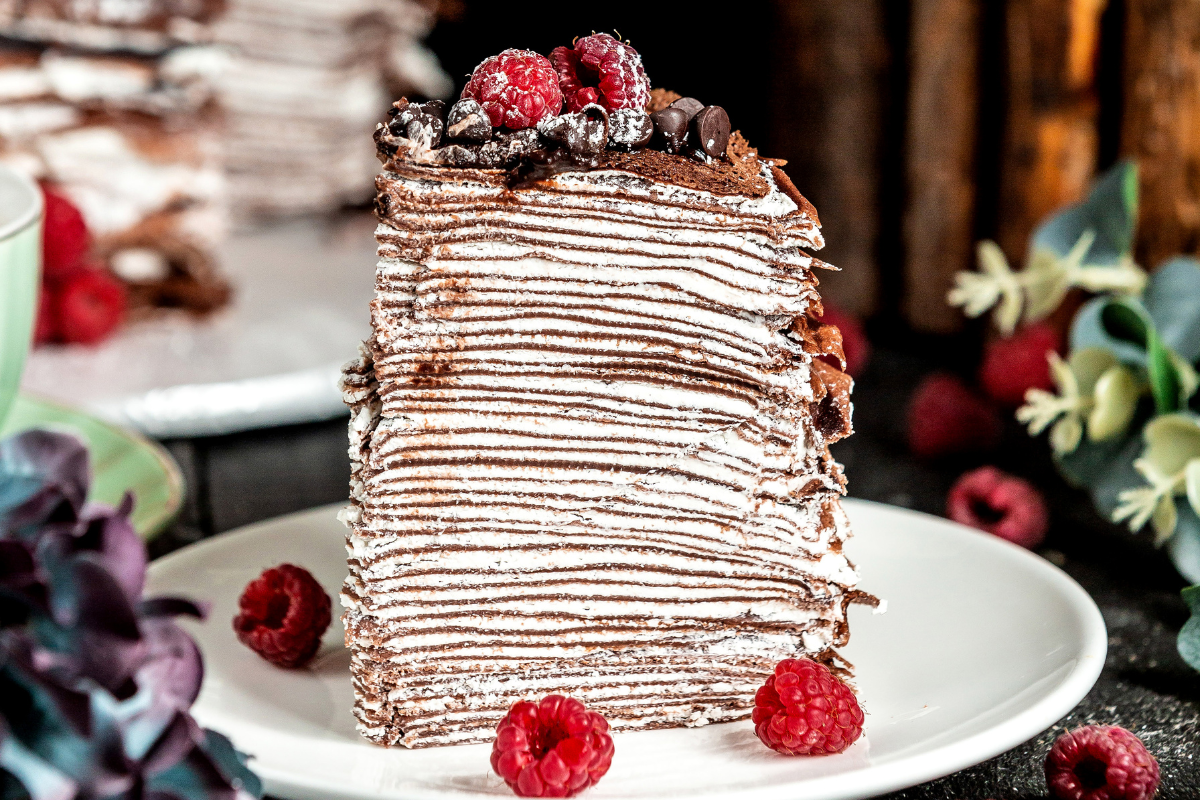Crepe cakes, with their delicate layers and rich flavors, have captured the hearts of dessert lovers worldwide. Originally a French creation, these cakes have evolved into a global phenomenon, with each variation offering its own twist on the classic recipe. However, while crepe cakes are undeniably delicious, they also carry a calorie count that health-conscious individuals need to consider. In this guide, we explore the calories content of crepe cake in detail, helping you enjoy this indulgence without compromising your dietary goals.
What Is a Crepe Cake?
A crepe cake, also known as a mille crepe cake, is a multi-layered dessert made from thin crepes stacked with layers of cream or other fillings. “Mille,” meaning “thousand” in French, signifies the numerous layers that make up the cake. Traditionally, these cakes use simple ingredients like eggs, flour, milk, and butter. However, modern variations often incorporate a wide range of flavors and toppings, from fruit compotes to chocolate ganache.
The concept of the crepe cake dates back centuries, with its roots in French patisserie. Over time, different cultures have adapted the dessert. Japan, for instance, has popularized matcha-flavored crepe cakes, while in the United States, gourmet patisseries have introduced inventive flavors with premium ingredients.
Detailed Caloric Content of Crepe Cakes
Not all crepe cakes are created equal when it comes to counting calories. The caloric content of a crepe cake varies based on the ingredients, slice size, and preparation method.
- Traditional Crepe Cakes: A standard slice of a traditional crepe cake, such as those from Lady M, usually contains around 450 calories. This calorie count comes from the rich cream between the layers, often made with heavy cream or mascarpone. The crepes themselves, cooked in butter, also contribute to the overall calorie content.
- Mille Crepe Cakes: Mille crepe cakes, known for their many layers (often 20 or more), feature paper-thin crepes filled with light pastry cream. A slice can range from 300 to 600 calories, depending on the recipe. A simpler version might contain around 300 calories, while a more decadent version could reach 600 calories per slice.
- Specialty Crepe Cakes: Specialty crepe cakes offer unique flavors and ingredients. For example, a Green Tea Mille Crepe Cake, with matcha in both the crepes and cream, might have slightly fewer calories than a chocolate version. However, a Chocolate Crepe Cake, featuring layers of chocolate ganache, can contain over 600 calories per slice due to the added sugar and fat.
Understanding the specific caloric content of these cakes helps you make informed choices, whether you’re indulging in a slice at a bakery or making one at home.
Factors Influencing Caloric Content
Several factors influence the number of calories in a crepe cake:
- Ingredient Variations: The choice of ingredients plays a major role in the overall caloric content of a crepe cake. Full-fat cream or butter results in a higher calorie count compared to low-fat or dairy-free alternatives. Additionally, the type of flour used can impact the calories, with white flour being higher in calories than whole wheat or alternative flours like almond or coconut flour.
- Serving Size and Preparation Methods: The size of the slice directly affects your calorie intake. A larger slice obviously contains more calories. The way the crepes are prepared also matters. Cooking the crepes in a generous amount of butter increases the calorie content, whereas using a non-stick pan with minimal oil reduces it.
- Impact of Toppings and Fillings: Toppings and fillings can significantly alter the calorie count of a crepe cake. Adding a layer of Nutella or thick chocolate ganache boosts the calorie content, while opting for fresh fruit or a light dusting of powdered sugar keeps the calories in check. Some crepe cakes are adorned with additional ingredients like nuts, caramel, or ice cream, all of which add to the calorie total.
By considering these factors, you can better manage your calorie intake while still enjoying this delicious dessert.
Health Considerations
While crepe cakes are undoubtedly a treat, you can enjoy them without completely derailing your diet. Here are some health considerations:
- Portion Control: Managing the calories you consume from a crepe cake is simple with portion control. Instead of indulging in a large slice, share it with a friend or save half for later. This allows you to enjoy the flavors without consuming an excessive number of calories.
- Nutritional Benefits of Certain Ingredients: Some ingredients in crepe cakes offer nutritional benefits. If you’re making a crepe cake at home, consider using whole grains by opting for whole wheat flour. Additionally, fresh fruit as a filling or topping adds vitamins, minerals, and antioxidants, making your dessert a healthier choice.
- Healthier Crepe Cakes: To reduce the calorie content of your crepe cake, consider using low-fat dairy products or dairy-free alternatives like almond or coconut milk for the cream. Experiment with sugar substitutes, such as stevia or monk fruit sweetener, to cut down on sugar. Another option is to add more layers of crepes with thinner layers of cream, reducing the overall calorie density of each slice.
These small adjustments allow you to enjoy a delicious crepe cake that aligns with your dietary goals.
Comparing Crepe Cake Calories with Other Desserts
To put the calorie content of crepe cakes into perspective, it’s helpful to compare them with other popular desserts:
- Crepe Cakes vs. Traditional Cakes: Traditional cakes, such as a classic chocolate or vanilla layer cake, typically contain around 350 to 500 calories per slice, depending on the size and ingredients. Crepe cakes often fall within a similar calorie range, but they can be more calorie-dense due to the multiple layers of cream and crepes. A smaller slice of crepe cake may have the same or more calories than a larger slice of traditional cake.
- Crepe Cakes vs. Cheesecakes: Cheesecakes are rich and calorie-laden, with a typical slice containing anywhere from 400 to 800 calories. In comparison, a crepe cake can be a lighter alternative, especially if it’s made with low-fat ingredients or fruit fillings. However, specialty crepe cakes with chocolate or caramel can rival the calorie content of a cheesecake.
- Crepe Cakes vs. Other Layered Desserts: Other layered desserts, such as tiramisu or baklava, can also be high in calories. Tiramisu usually contains around 450 to 600 calories per slice, while baklava, with its layers of filo pastry and honey, can have up to 500 calories per piece. Crepe cakes, depending on their ingredients, can be a more moderate option, particularly if made with lighter fillings.
These comparisons show that while crepe cakes can be indulgent, they are not necessarily higher in calories than other popular desserts. The key is to choose your portion size and ingredients wisely.
Cultural Significance and Enjoyment
Crepe cakes are not just a delicious dessert; they also hold cultural significance in many parts of the world. In France, crepes are a traditional food often enjoyed during celebrations like La Chandeleur, a festival held in early February. In Japan, crepe cakes have become popular in cafes, with matcha and other local flavors incorporated into the recipes.
Crepe cakes are often seen as a sophisticated dessert that can be served at weddings, birthdays, and other gatherings. The delicate layers and customizable flavors make them a versatile choice for any event.
To incorporate crepe cakes into a balanced diet, moderation is key. Enjoying a slice as part of a celebratory meal is fine, especially when balanced with healthier options like fruits and vegetables. By savoring each bite and appreciating the craftsmanship that goes into making a crepe cake, you can enjoy this dessert without guilt.
Making Crepe Cakes at Home

One of the best ways to control the calorie content of a crepe cake is to make it at home. Here’s a basic recipe and tips for creating a healthier version:
- Basic Crepe Cake Recipe:
- Ingredients:
- 1 cup all-purpose flour (or whole wheat flour for a healthier option)
- 2 large eggs
- 1 1/2 cups milk (or almond milk)
- 2 tablespoons melted butter (or coconut oil)
- 1 tablespoon sugar (optional)
- 1 teaspoon vanilla extract
- Instructions:
- In a mixing bowl, combine the flour, eggs, and milk. Whisk until smooth.
- Stir in the melted butter, sugar, and vanilla extract.
- Heat a non-stick skillet over medium heat. Pour a small amount of batter into the pan, swirling to create a thin, even layer.
- Cook for 1-2 minutes on each side until lightly browned. Repeat with the remaining batter.
- Stack the crepes with layers of cream or filling of your choice.
- Refrigerate the cake for at least 1 hour before serving.
- Ingredients:
- Tips for Reducing Calories:
- Use low-fat or non-dairy milk options.
- Replace some of the cream layers with fresh fruit, such as sliced strawberries or bananas.
- Use a sugar substitute or reduce the sugar in the recipe.
- Ingredient Substitutions for a Healthier Version:
- Whole wheat or almond flour instead of all-purpose flour.
- Greek yogurt or whipped coconut cream instead of heavy cream.
- Honey or maple syrup instead of refined sugar.
These adjustments allow you to enjoy a delicious crepe cake that is lower in calories and packed with flavor.
FAQs About Crepe Cake Calories
How Many Calories Are in a Slice of Crepe Cake? The calories in a slice of crepe cake can range from 178 to 601, depending on the ingredients and size of the slice.
Is Crepe Cake Healthier Than Regular Cake? Crepe cakes can be denser and more calorie-rich than regular cakes, depending on the ingredients. However, they can also be made with lighter ingredients, making them a potentially healthier option.
Can I Make a Low-Calorie Crepe Cake? Yes, by using low-fat cream, reducing the sugar content, and incorporating more fruits, you can create a lower-calorie version of a crepe cake.
How Do I Store Crepe Cake? Store crepe cakes in the refrigerator for up to three days. It’s best to cover the cake with plastic wrap or place it in an airtight container to prevent it from drying out.
Can I Freeze Crepe Cake? Yes, you can freeze crepe cakes, although the texture may change slightly upon thawing. To freeze, wrap the cake tightly in plastic wrap and then in aluminum foil. Store it in the freezer for up to one month.
What Are Some Popular Crepe Cake Flavors? Popular crepe cake flavors include vanilla, chocolate, matcha, lemon, and strawberry. You can also experiment with flavors like coffee, caramel, or Nutella.
Conclusion
Crepe cakes are a delicious and indulgent dessert that can fit into your diet with a little planning and moderation. By understanding how many calories are in a crepe cake, you can make informed choices about portion sizes and ingredients. Whether you enjoy a traditional mille crepe or experiment with new flavors, crepe cakes offer a unique and satisfying treat for any occasion.
The key to enjoying crepe cakes is balance. By savoring each layer and being mindful of the ingredients, you can indulge in this dessert without overindulging in calories. So go ahead, enjoy a slice of crepe cake, and appreciate the artistry and flavor that make this dessert so special.
in conclusion a crepe cake, often referred to as a mille crepe cake, is a French-inspired dessert made by stacking layers of crepes with alternating layers of cream or other fillings. If you’re curious about the process, check out this guide on How to Make Crepe Cake.

